Few elements elevate a dining room faster than the soft crackle and golden glow of a fireplace. Whether your space is a grand salon or a breakfast nook, today’s hearth technology—ranging from classic brick-and-mortar builds to ventless electric inserts—makes it possible to add warmth, light, and architectural interest without ripping out half the house. Designers continually showcase fireplaces as zone dividers, art pieces, and conversation starters, proving the feature’s versatility for open plans and cozy cottages alike. Explore the twenty ideas below, each distilled into actionable steps that help you transform everyday meals into memorable gatherings.
1. Classic Brick Fireplace Sets a Welcoming Dining Room Tone

An exposed-brick fireplace instantly grounds a dining room in tradition while offering endless styling potential. Start by cleaning and sealing the masonry so its natural texture steals the spotlight, then echo those earthy reds with woven chair seats or terracotta planters for cohesive warmth. If the brick feels dated, try a limewash or German-smear finish to soften the tone while preserving character. Southern design editors applaud these subtle whitewashing techniques for keeping rooms bright without erasing history. Finish the look with a chunky wood mantel that hosts seasonal centerpieces, layer a jute rug under the table, and invite lingering conversation long after dessert.
2. Double-Sided Dining Room Fireplace Divides and Connects
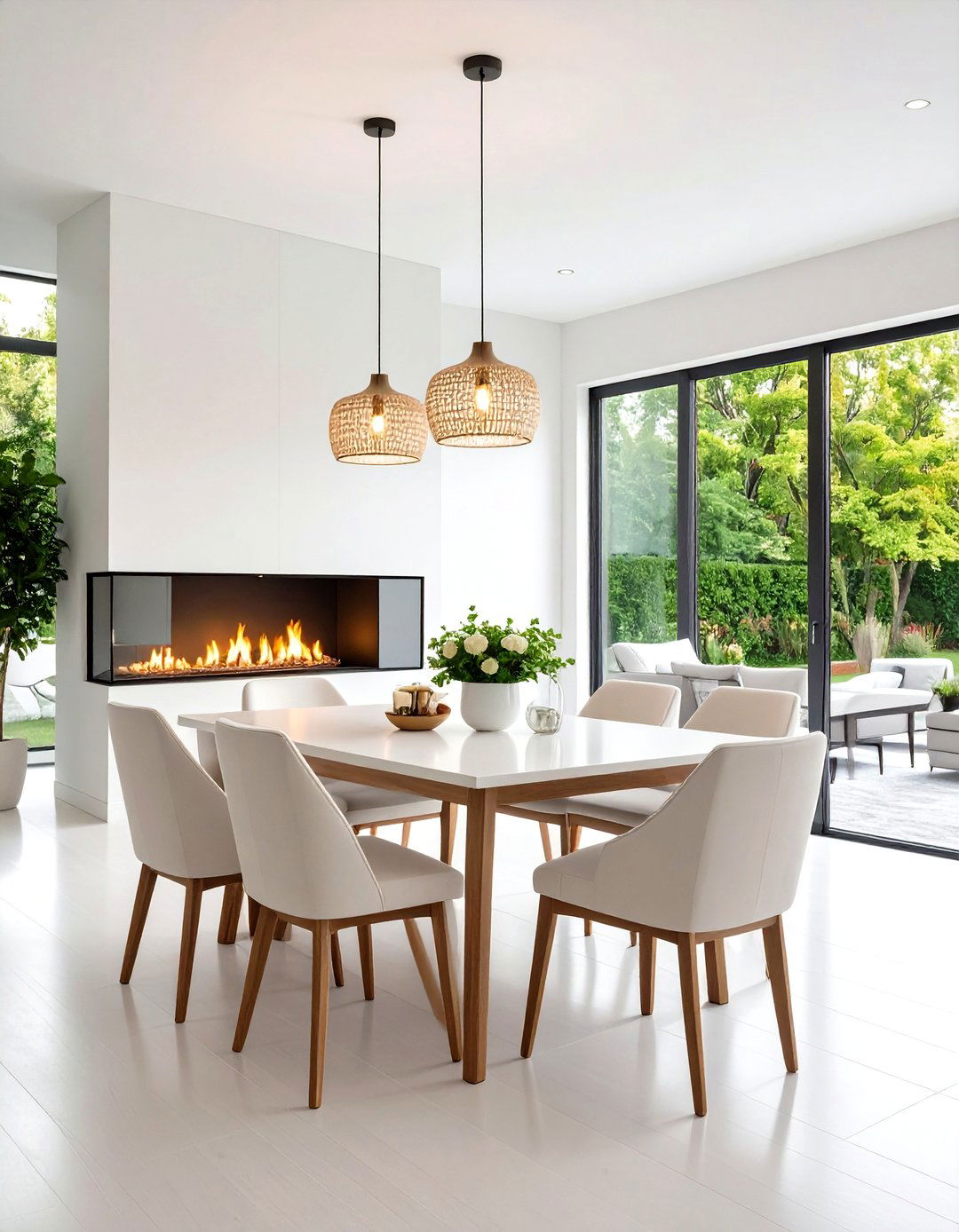
Unlike a solid wall, a double-sided fireplace lets your dining room share dancing light with the adjoining lounge, boosting intimacy everywhere. Center the see-through firebox in a half-height partition so conversation and sightlines stay uninterrupted. Because heat radiates on both faces, you can choose a narrower unit and smaller hearth footprint. Designers often specify low-iron glass, which minimizes green tint and keeps flames looking crisp. Dress the partition in the same finish as surrounding cabinetry to make the architectural move feel deliberate. The Spruce’s showcase of two-room hearths demonstrates how this approach doubles ambience without blocking sunlight. Remember a three-foot clearance behind chairs so servers can pass safely when plates arrive.
3. Space-Saving Corner Fireplace for Petite Dining Rooms

For a compact dining room, a corner fireplace reclaims underused diagonal space and frees full walls for cabinets. Position the hearth at a forty-five-degree angle so every seat enjoys a direct view of the flames. Better Homes & Gardens notes that angled placement simplifies furniture layouts, forming a focal triangle between table and hutch. Choose a shallow insert or electric log set if the chimney chase intrudes on circulation. To keep the corner from feeling dark, flank the surround with open shelving that displays sparkling glassware. A ceiling-height stone veneer draws the eye upward, subtly exaggerating the room’s perceived size. Finish with a rug that mirrors the hearth’s diagonal line to reinforce cohesion.
4. Electric Fireplace Adds Safe Warmth to Modern Dining Rooms

Electric fireplaces are a safe, vent-free way to bring year-round ambiance to the dining room, especially in apartments without chimneys. Choose a recessed linear model that slides between studs so the wall stays flush and uncluttered. Manufacturers point out that no combustible gases are produced, so artwork can hang just inches above the glass. Belleze’s safety guide highlights cool-touch exteriors and automatic overheat shut-offs, making them kid- and pet-friendly. Because flame and heat operate separately, you can enjoy flicker during summer dinners without roasting guests. Look for LED logs with adjustable ember colors to coordinate with table linens, and conceal cords behind chair rails before you patch the drywall.
5. Suspended Fireplace Brings Scandinavian Drama to Dining Rooms
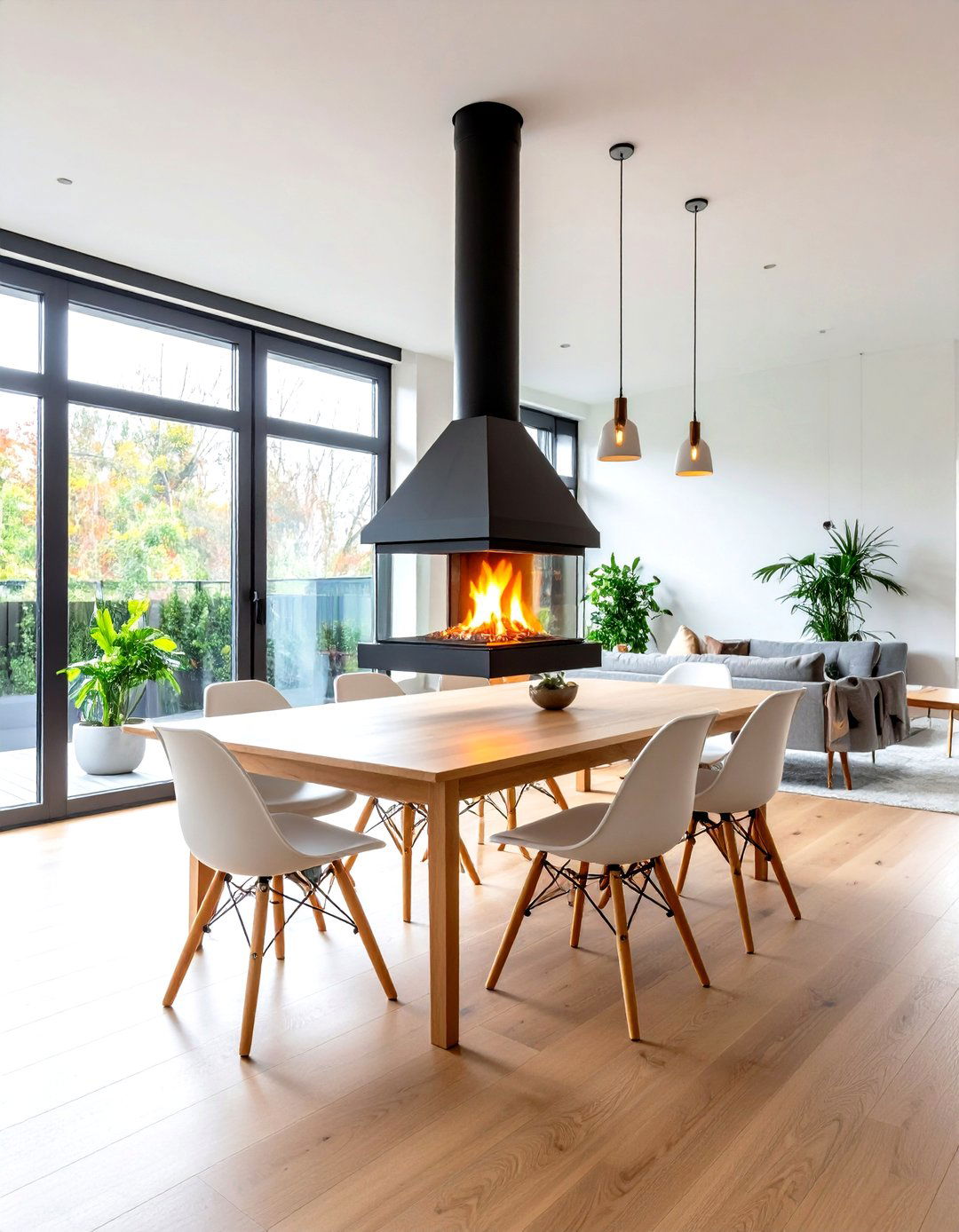
A suspended fireplace brings Scandinavian drama, keeping the dining room floor clear while the flame hovers like sculpture. Ceiling-hung models pivot, so you can swivel the firebox toward guests for dessert theatrics or away during cleanup. Houzz galleries of Nordic dining rooms emphasize matching the steel finish to pendant lights for cohesion. Because these stoves vent through a single flue, you gain more wall space for sideboards or art. Ensure joists can handle the combined unit and chimney weight; manufacturers provide mounting plates. Add a circular hearth pad—stone, glass, or concrete—to catch sparks and echo the floating silhouette. Choose low-back chairs that keep sightlines to the fire uninterrupted.
6. Eco-Friendly Bioethanol Fireplace Updates Dining Room Ambience
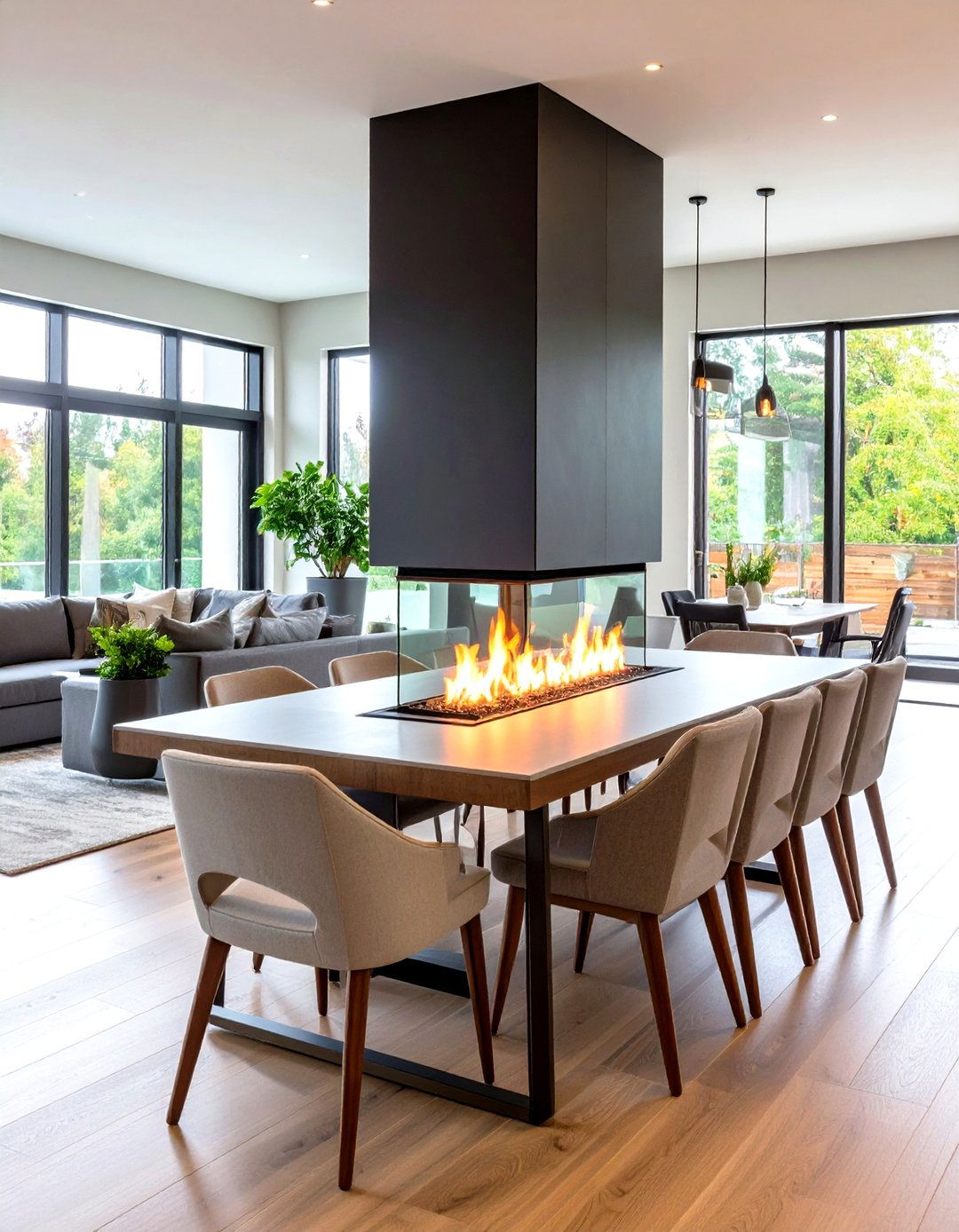
Eco-conscious hosts love bioethanol fireplaces because they burn plant-based fuel without smoke, ash, or chimneys. You can center the hearth on an interior wall—even in a rental—using only masonry screws. Industry comparisons show bioethanol models release roughly the same carbon dioxide as burning three candles, making air-quality complaints rare. Many include refill canisters that slide into drawers beneath the burner, so messy funnels disappear. Pick a long, low trough style; its horizontal flame mimics candle rows down a banquet table. Mounting the trough at elbow height lets guests warm hands safely between courses. Finish with tempered-glass guards that block gusts but let the flicker shine during open-window evenings.
7. Built-In Banquette Around the Fireplace Encourages Cozy Dining
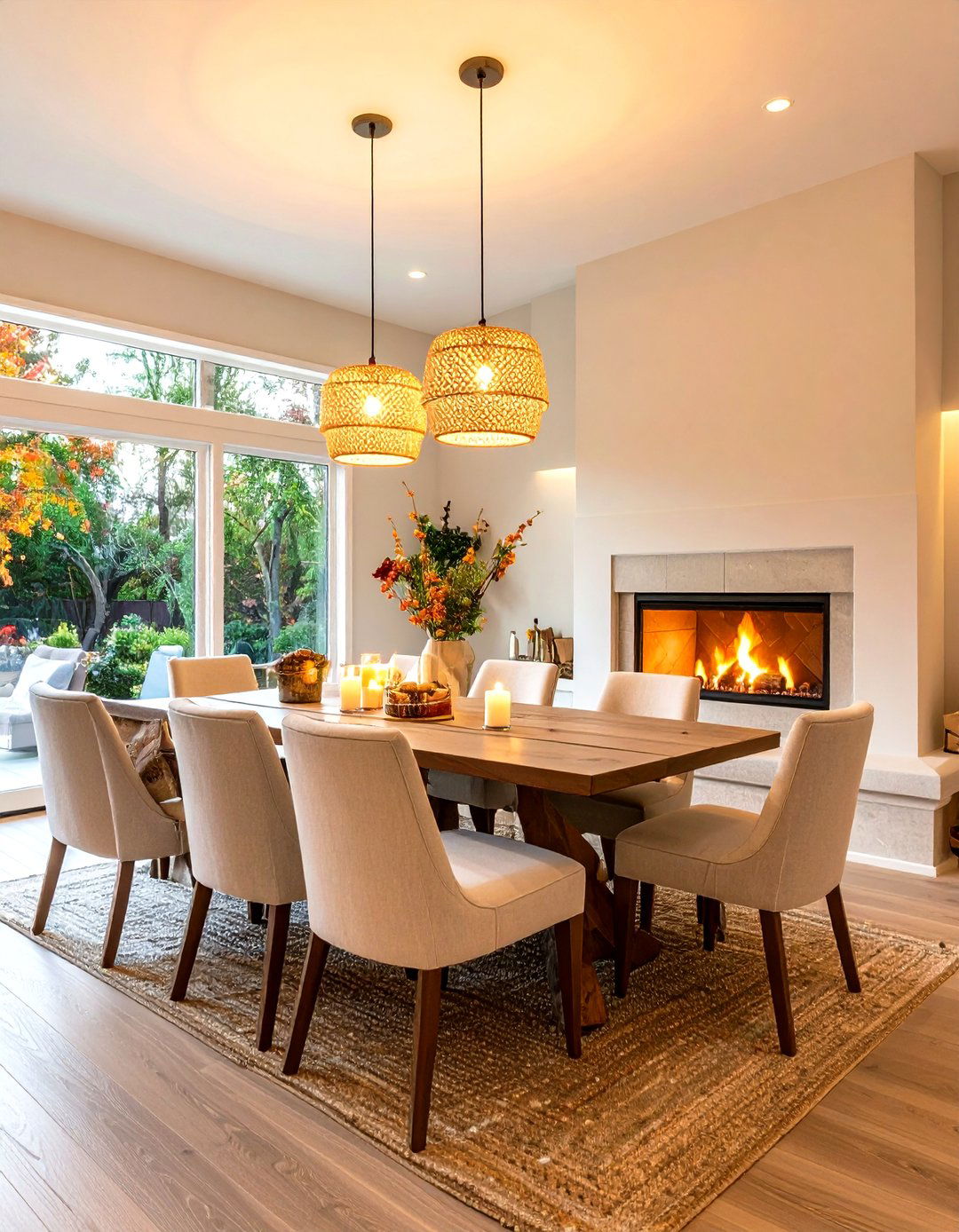
Consider wrapping a cushioned banquette around the base of your dining-room fireplace to turn extra heat into extra seating. This move eliminates chair crowding and gives family members a place to lounge before meals. Open-concept designers often add built-in benches and shelves beside the hearth so dinnerware and games stay handy. Maintain ergonomics by setting seat depth around eighteen inches and topping it with high-density foam. A channel-tufted backrest shields diners from excessive warmth while adding subtle texture. If the hearth projects outward, terminate the bench a few inches short to clear fire tools. Finish with sconce lighting so lingering guests aren’t left in shadow.
8. Sculptural Stone Fireplace Becomes Dining Room Art Piece
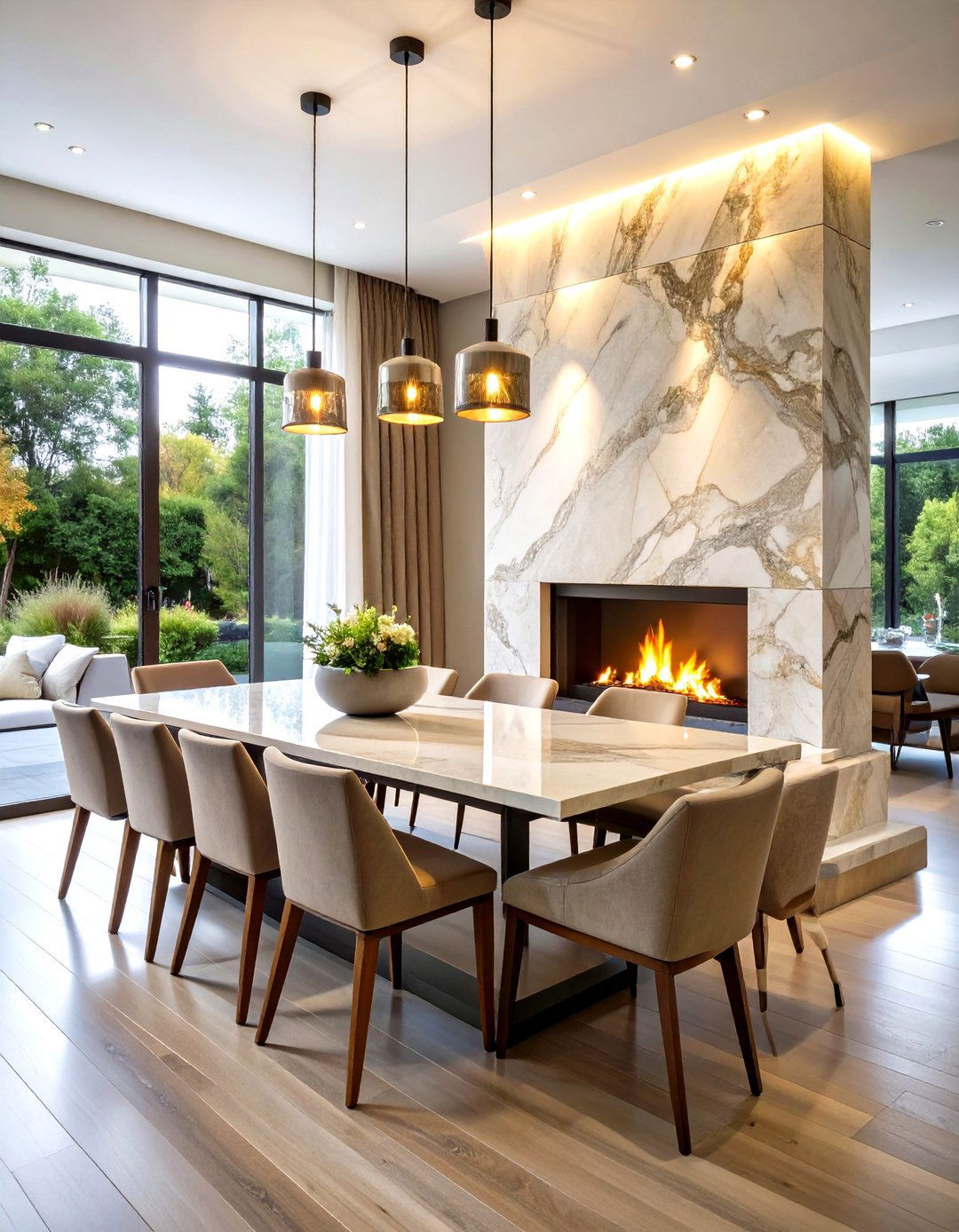
A sculptural stone fireplace can function as artwork, giving the dining room a gallery feel without adding clutter. Opt for heavily veined marble or textured limestone slabs that wrap the firebox in clean mitred joints. Elle Décor notes that limiting your material palette lets natural pattern become the story, ensuring timeless appeal. Pair the stone with ultra-slim track lighting so evening dinners sparkle across the polished surface. Keep furnishings low and monochrome so the fireplace remains the focal point. If full slabs exceed budget, stone-look porcelain panels deliver similar drama for less. Seal porous stone annually to guard against red-wine splashes and fondue mishaps.
9. Minimalist Linear Fireplace Keeps Contemporary Dining Room Clean
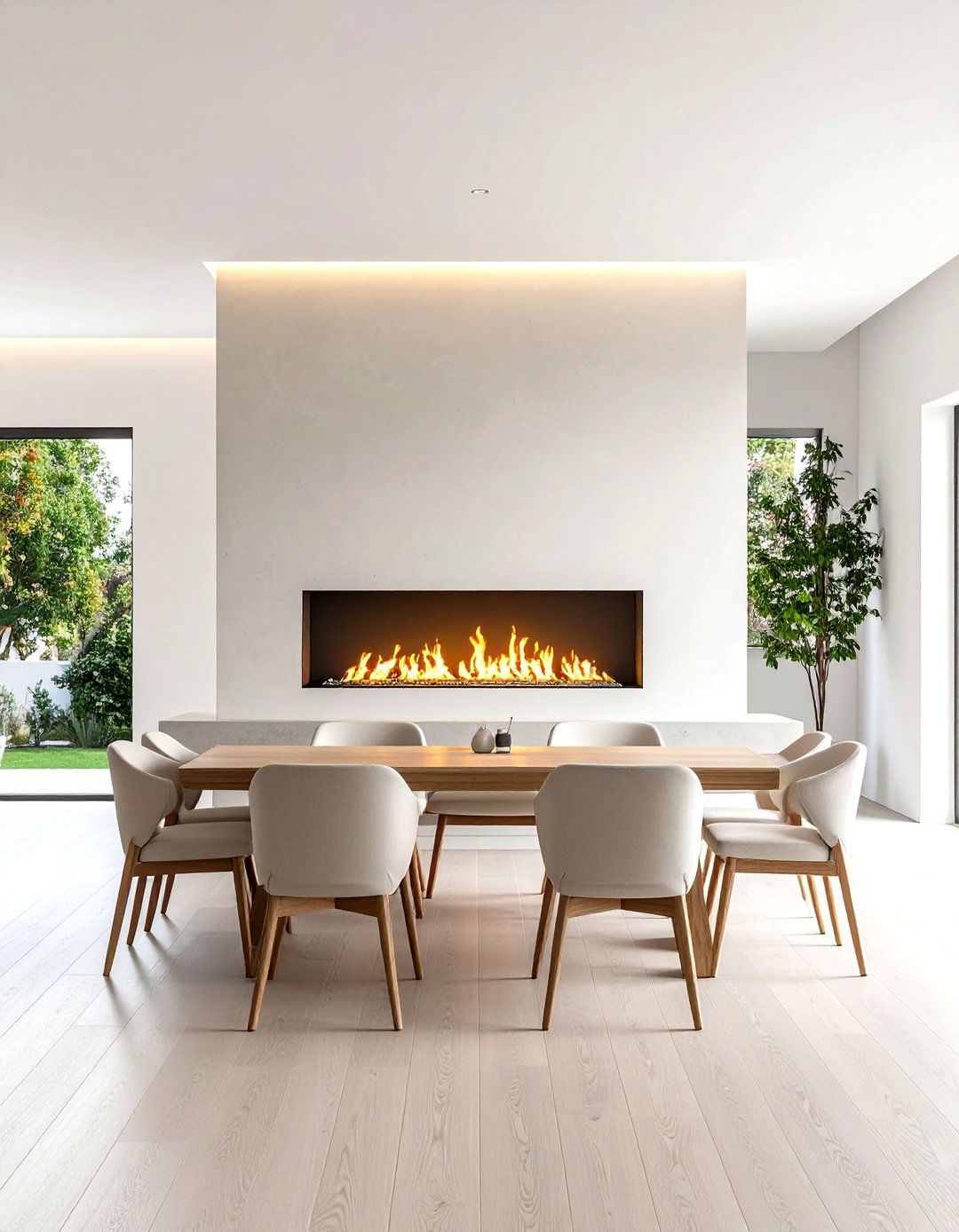
For modernists, a minimalist linear fireplace installed at eye level creates a horizon line across the dining room wall. Select a frameless trim kit so flame appears to emerge directly from plaster or concrete. Heat & Glo’s slim ribbon models recess into two-by-six studs, allowing artwork or television mounting above without code issues. Keep the wall quietly monochrome—microcement or matte limewash—so the flame’s horizontal line steals the show. A low, continuous bench beneath the opening doubles as wood storage, reinforcing the sleek silhouette. During daylight, dark glass reads as a reflective stripe, adding subtle architectural interest even when dormant. Install a smart thermostat so the unit idles at low heat during multi-course meals.
10. Reclaimed Wood Mantel Introduces Rustic Soul to Dining Rooms
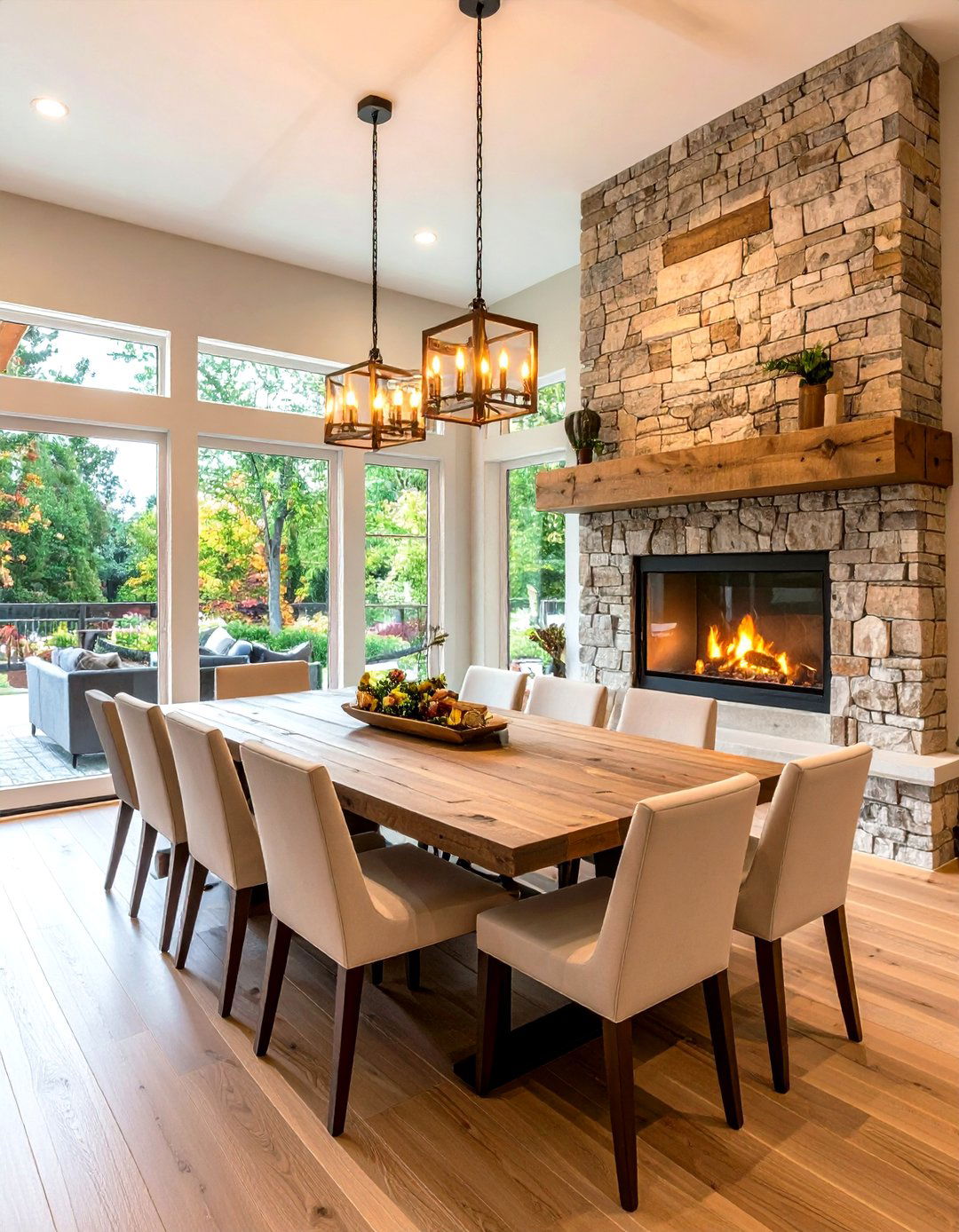
A reclaimed-wood mantel instantly adds narrative, suggesting your dining room fireplace has warmed families for generations even if it’s newly built. Look for beams salvaged from barns or mills; their axe marks and nail holes provide authentic patina. Better Homes’ salvage guide explains how sealing reclaimed timber with matte poly protects diners from splinters without dulling character. Combine the rough mantel with a sleek insert to balance rustic and contemporary aesthetics. Continue reclaimed planks up the chimney breast for a cabin-in-the-city vibe. Undermount linear LED strips beneath the beam dramatize texture while guiding guests to their seats. Finish the tableau with forged-iron hooks that double as napkin-ring storage.
11. Glass-Front Fireplace Frames Views from the Dining Room

A three-sided glass fireplace lets diners admire flames from any chair and maintains open views to surrounding rooms. These units often feature zero-clearance construction, so a narrow steel frame can float almost flush with drywall. Manufacturers note that floor-to-ceiling glass boosts light distribution and helps small dining rooms feel more expansive. To prevent glare during brunch, install motorized screen shades on windows opposite the fire. Because heat radiates through three panes, choose low-iron ceramic glass that tolerates higher temperatures without clouding. Frame the base with a stone plinth that doubles as bench seating. Keep tabletop décor low so the continuous flame remains the star of every shared meal.
12. Industrial Steel Fireplace Highlights Loft-Style Dining Rooms
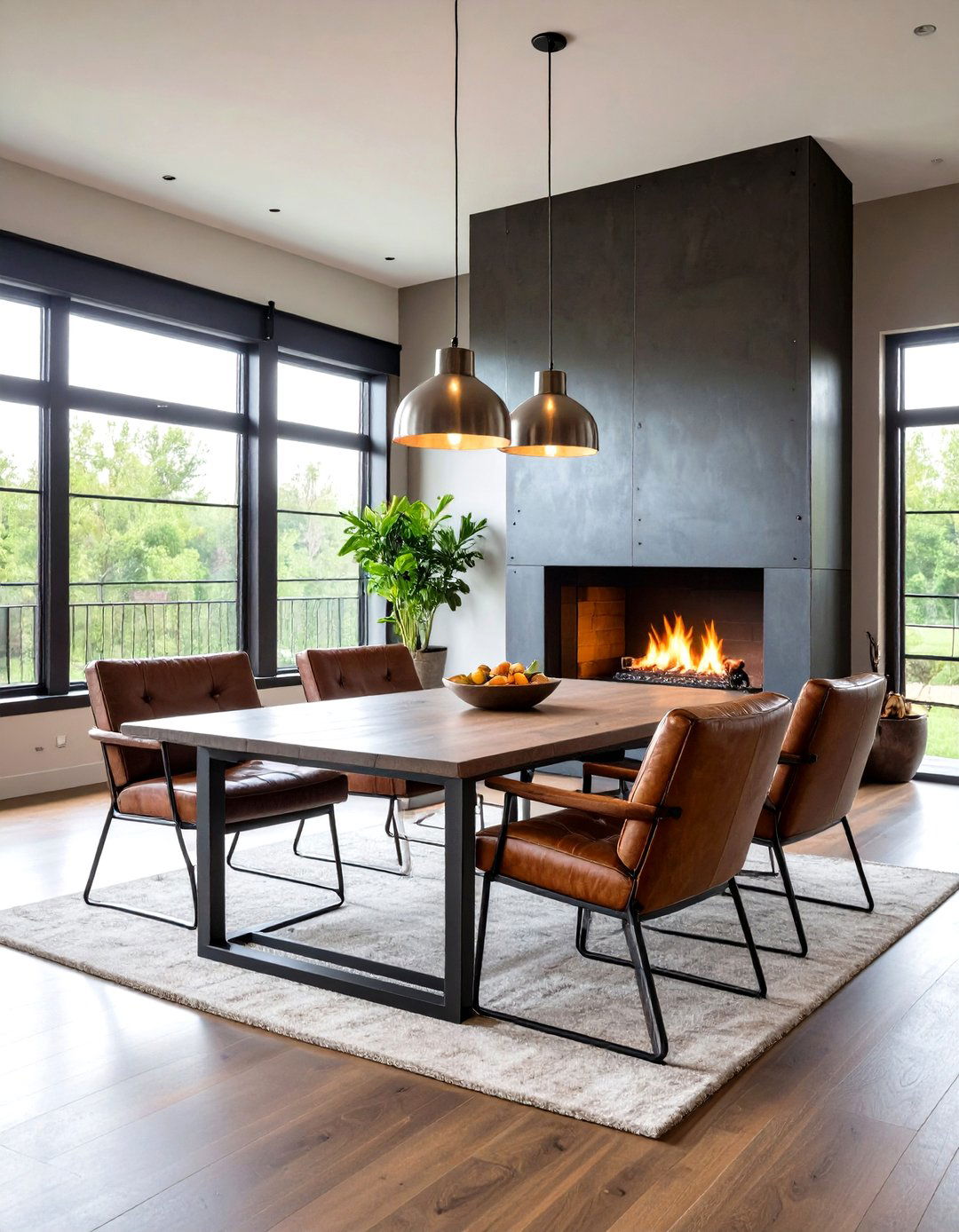
If your loft-style dining room leans industrial, a raw-steel fireplace can echo exposed beams and ductwork while adding soulful warmth. Trendir spotlights welded steel hearths whose intentional grind marks read like abstract art. Pair the metal with leather sling chairs and Edison-bulb pendants to reinforce factory-inspired vibes. Because unfinished steel can oxidize, seal surfaces with high-heat clear coat to stop rust stains on flooring. A recessed log niche framed in the same metal carries the theme and supplies visual rhythm. Balance the hard edges with a vintage Persian rug under the table to soften acoustics. Add dimmable uplights behind the surround to wash brick walls in a warm gradient.
13. Vintage Cast-Iron Stove Charms Cottage Dining Rooms

A cast-iron stove tucked into the dining room revives Victorian charm without major construction. Real Simple’s product tests highlight modern electric stoves that mimic coal beds while offering thermostat control and plug-in convenience. Position the unit at the table’s end so diners can watch embers as plates circulate. Stoves weigh less than masonry fireplaces, making them suitable for upper floors with limited load capacity. Slip a six-inch vent pipe through an exterior wall if choosing wood or gas; electric models need only an outlet. Paint nearby trim deep charcoal to harmonize with the iron body and make brass hardware pop. Round out the vignette with pewter candlesticks that echo the stove’s finish.
14. Fireplace Wall with Integrated Storage Streamlines the Dining Room
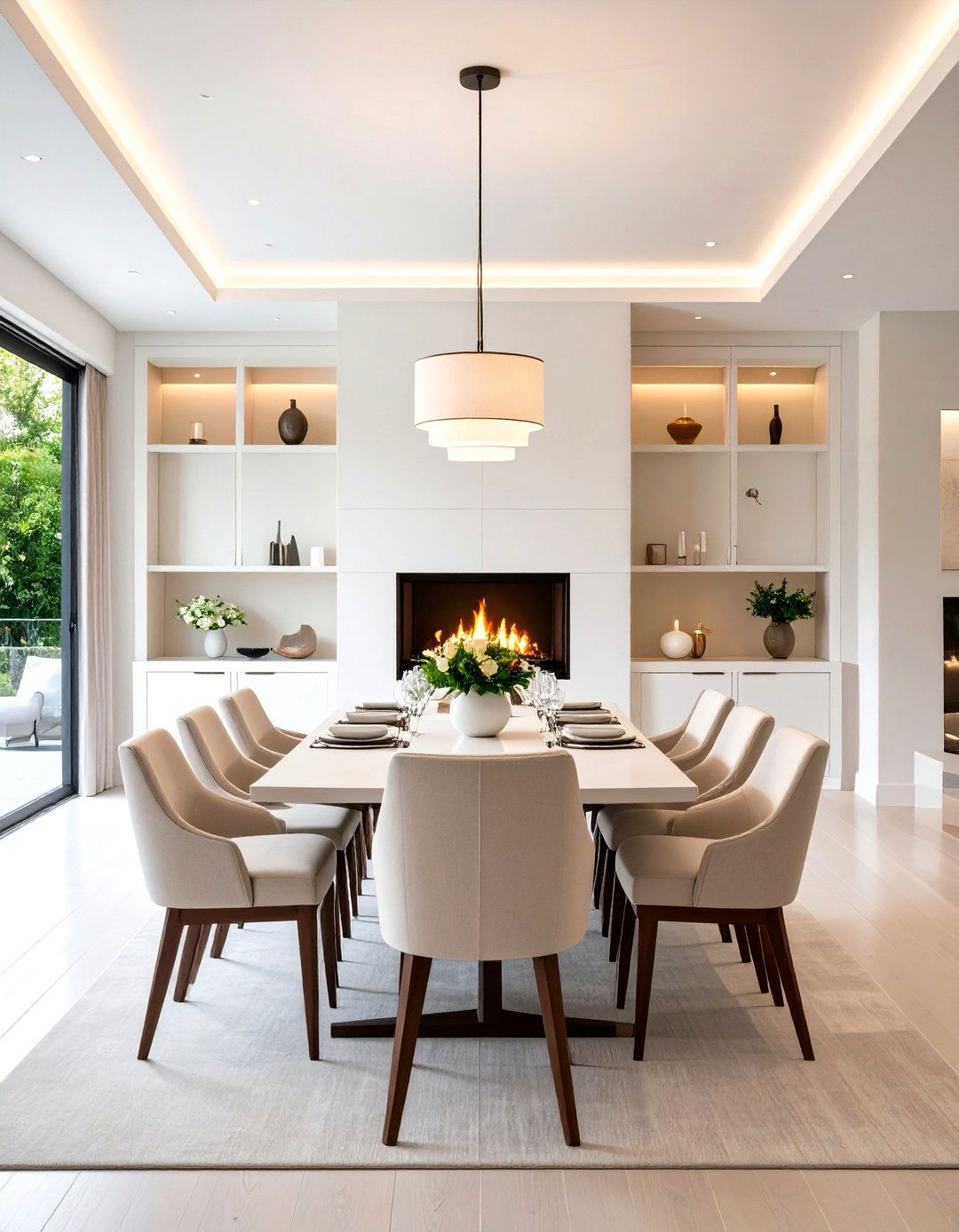
A full-height fireplace wall fitted with symmetrical cabinetry lets the dining room combine spectacle and storage in one stroke. Dedicate lower cupboards to table linens and glassware, while open shelves above display heirloom pitchers under LEDs. Houzz designers suggest using the same paint color across doors and chimney breast so the assembly reads like built-in architecture. Anchor the scheme with elongated brass pulls that align vertically, echoing the hearth’s proportions. Inside the mantel cavity, hide a slim speaker bar; flames reflect sound softly, creating dinner-music ambience. Pair wood-tone cabinetry with a matte-plaster chimney to balance warm tradition and minimalism. Finish by routing ventilation gaps behind shelves to prevent glassware fogging in winter.
15. Fireplace Mantel Niche Displays Art Above the Dining Table
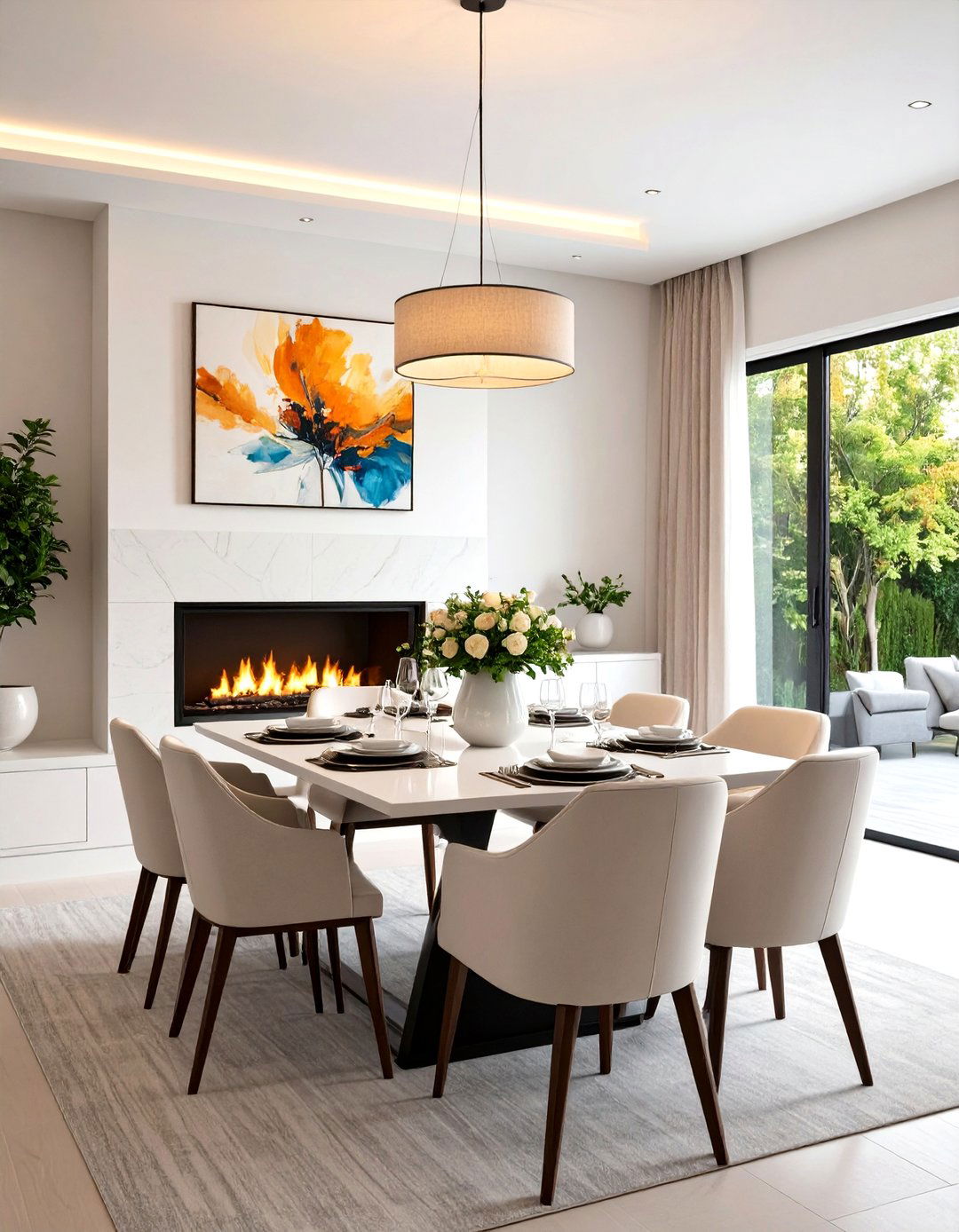
Carving a shallow niche above the fireplace gives your dining room a ready-made gallery slot for rotating artwork. Inset a thin marble ledge inside the recess so frames stand upright without visible easels. Elle Décor’s 2025 feature on mantel styling recommends coordinating mat colors with table linens to pull sightlines downward. Keep art no wider than two-thirds the fire opening to preserve pleasing proportions. Swap the piece seasonally—florals in spring, abstract landscapes in winter—to refresh the room without new furniture. Install dimmable picture lights inside the niche to prevent glare on glass-fronted frames. A bead-milled metal edge around the niche echoes cutlery sheen, tying the dining experience together.
16. Partial-Height Fireplace Wall Defines Open-Plan Dining Room
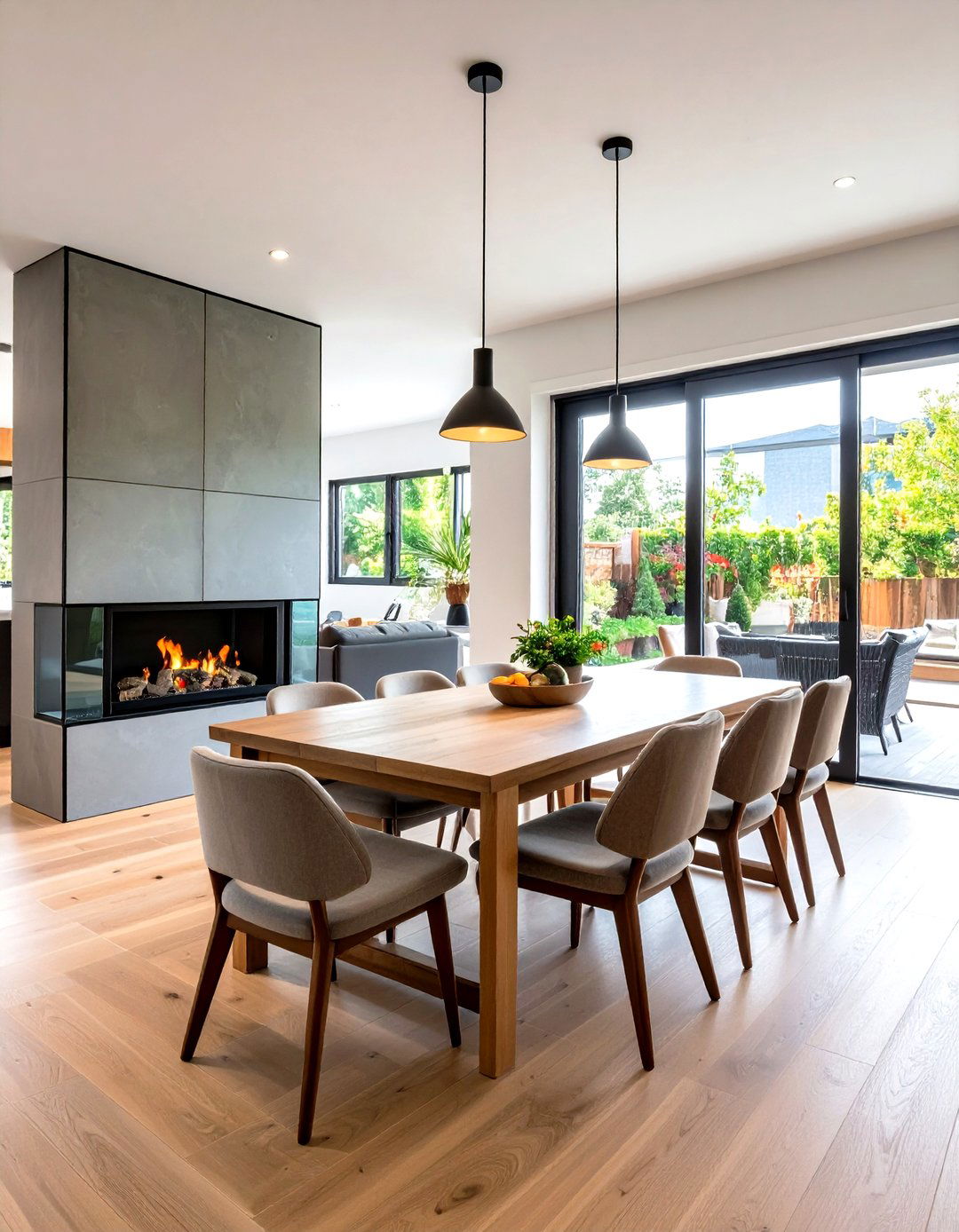
A partial-height fireplace wall can subtly divide kitchen and dining zones while conversation flows overhead. Designers at Bespoke Fireplace Designs advise placing the opening at seated eye level for easy cross-room connection. Cap the wall one meter above tabletop height, then top it with tempered glass to catch steam but not sightlines. Running gas lines through the floating structure is easier than venting a full chimney, cutting installation time. Add identical stone on both façades so guests feel equally honored regardless of seating. The low height leaves room for pendant lights to hover over each zone without chaos. Route a slim duct through the plinth to draw cool air and improve heat circulation.
17. Whitewashed Brick Fireplace Lends Coastal Calm to Dining Rooms

Whitewashing an existing brick fireplace instantly brightens the dining room, reflecting candlelight yet preserving rustic texture. Southern Living’s makeover roundup recommends mixing equal parts water and flat latex paint, then wiping off excess for soft variation. Follow with a clear matte sealer so soup splatters wipe clean during family feasts. Pair the white hearth with bleached-oak chairs and linen drapes to amplify breezy coastal vibes. For subtle depth, leave mortar joints slightly darker than bricks, creating gentle shadow lines at night. Hang woven baskets or seascape prints above the mantel to reinforce relaxed vacation moods. Because paint lightens brick, you can lower overhead wattage and still maintain an inviting glow.
18. Painted Mantel Adds Bold Color to Dining Room Fireplaces
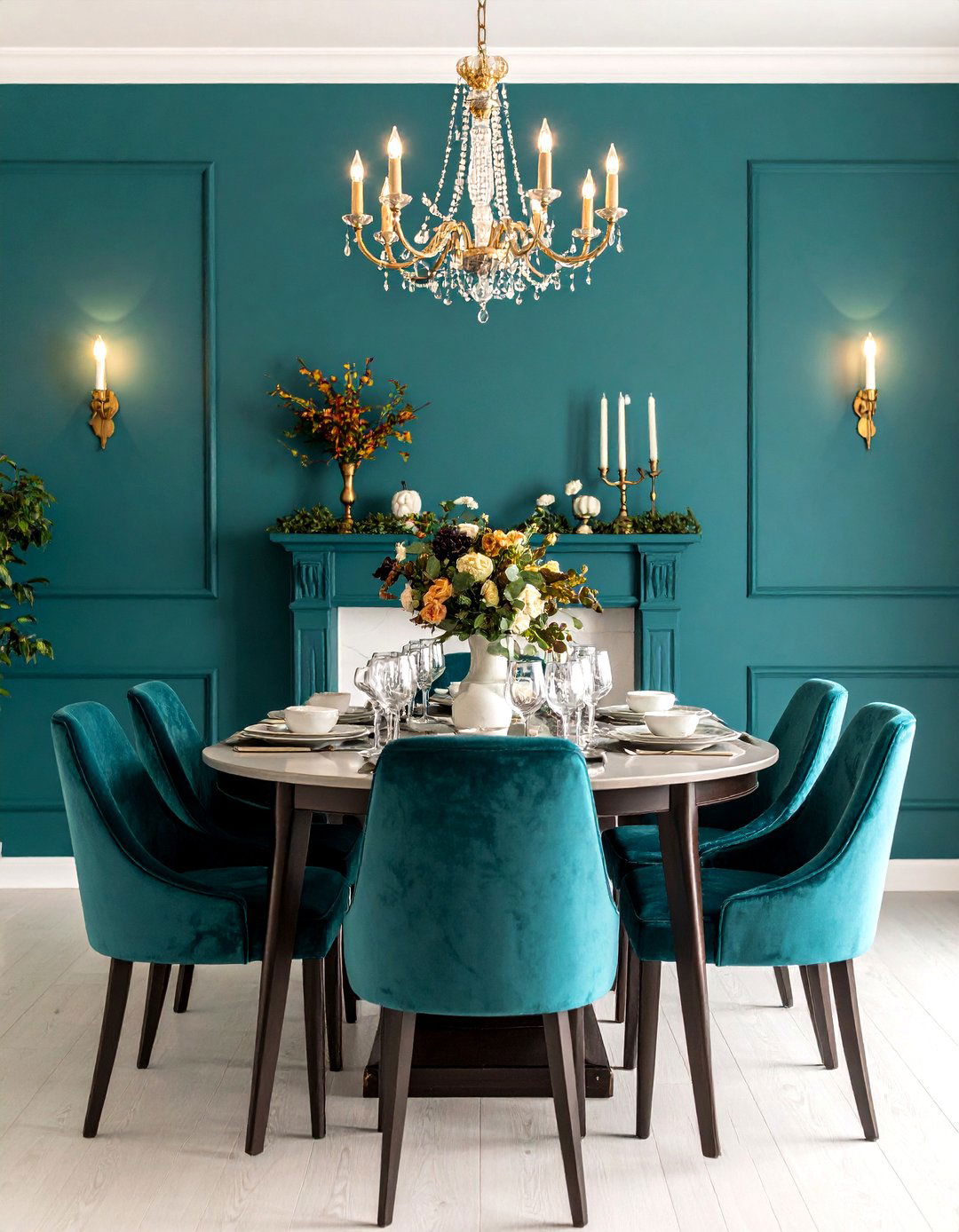
A boldly painted mantel turns the fireplace into a frame for color, allowing your dining room to express personality with a single stroke. Elle Décor showcases designers using deep teal or aubergine surrounds that contrast sharply against neutral plaster chimneys. To keep things sophisticated, match the mantel hue to an accent stripe on nearby upholstery. Lightly sand existing wood and apply bonding primer so pigments adhere evenly. Because paint scorches above 200 °C, choose a high-heat enamel rated for hearth use. Finish with matte clear coat to prevent fingerprints and provide velvety sheen. Repeat the color on candlesticks or charger plates so the room feels curated, not accidental.
19. Mirror-Clad Fireplace Amplifies Light in Compact Dining Rooms
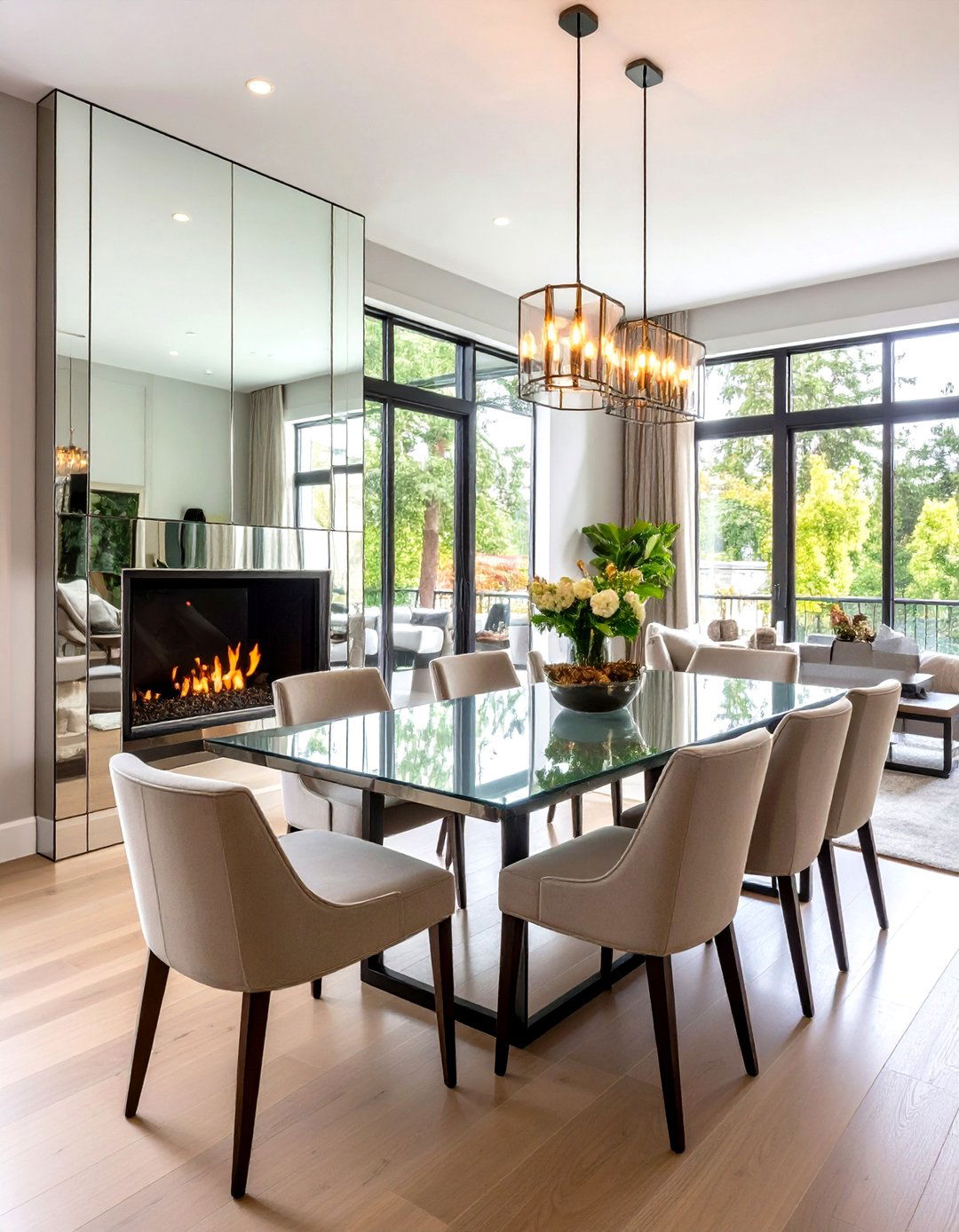
Cladding a slim fireplace surround in mirrored tile bounces daylight across the dining room and makes small spaces feel twice as wide. Elle Décor’s trend report features reflective hearths that read like sculptural light fixtures after dark. Use bevel-edged glass for jewelry-box sparkle or smoked mirror for moodiness. Install heat-resistant adhesive mats rather than conventional mortar to avoid cracking delicate tiles. Because reflections double visual clutter, keep mantel styling minimal—perhaps a single vase of eucalyptus. Dim the room and light pillar candles during dinner to see flickering flames dance infinitely in the mirrored surface. Wipe tiles with vinegar-water weekly to remove soot film without streaking.
20. Ventless Fireplace Offers Year-Round Dining Room Flexibility
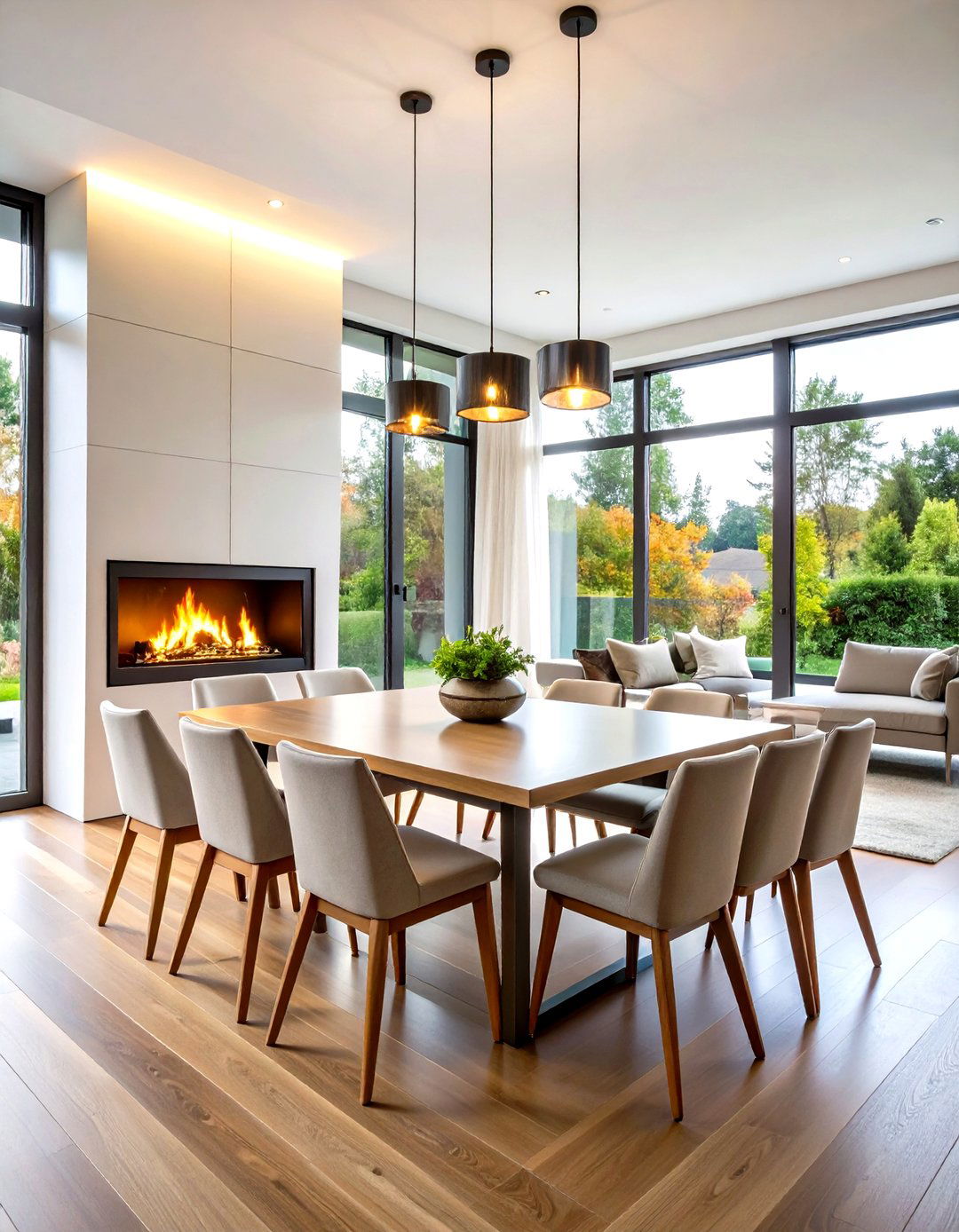
A ventless fireplace can run with or without heat, letting your dining room glow all year. Electric units stay cool and auto-shut off, making them safe around kids and linens. Because no chimney is required, you can recess the unit into a partition or buffet cabinet, saving floor space. Select models with colour-changing LEDs; warm amber complements autumn tablescapes, while icy blue feels refreshing during monsoon evenings. Remote or app control lets you dim flames between courses without leaving your seat. Keep the room ventilated; although emissions are low, fresh air preserves guest comfort during long celebrations. Finish with a slim stone ledge at plate level so diners can rest glasses near the glow.
Conclusion:
From mighty brick hearths to sleek bioethanol troughs, a fireplace can anchor your dining room’s style, improve comfort, and even carve out distinct zones in an open floor plan. Choose the idea that suits your architecture—corner placement for tight quarters, a double-sided divider for social flow, or a color-drenched mantel for instant drama—and pair it with thoughtful furniture spacing and heat-safe finishes. Whichever direction you pick, you’ll gain more than warmth; you’ll create a gathering place that invites conversation, lingers over dessert, and leaves guests eager to come back.


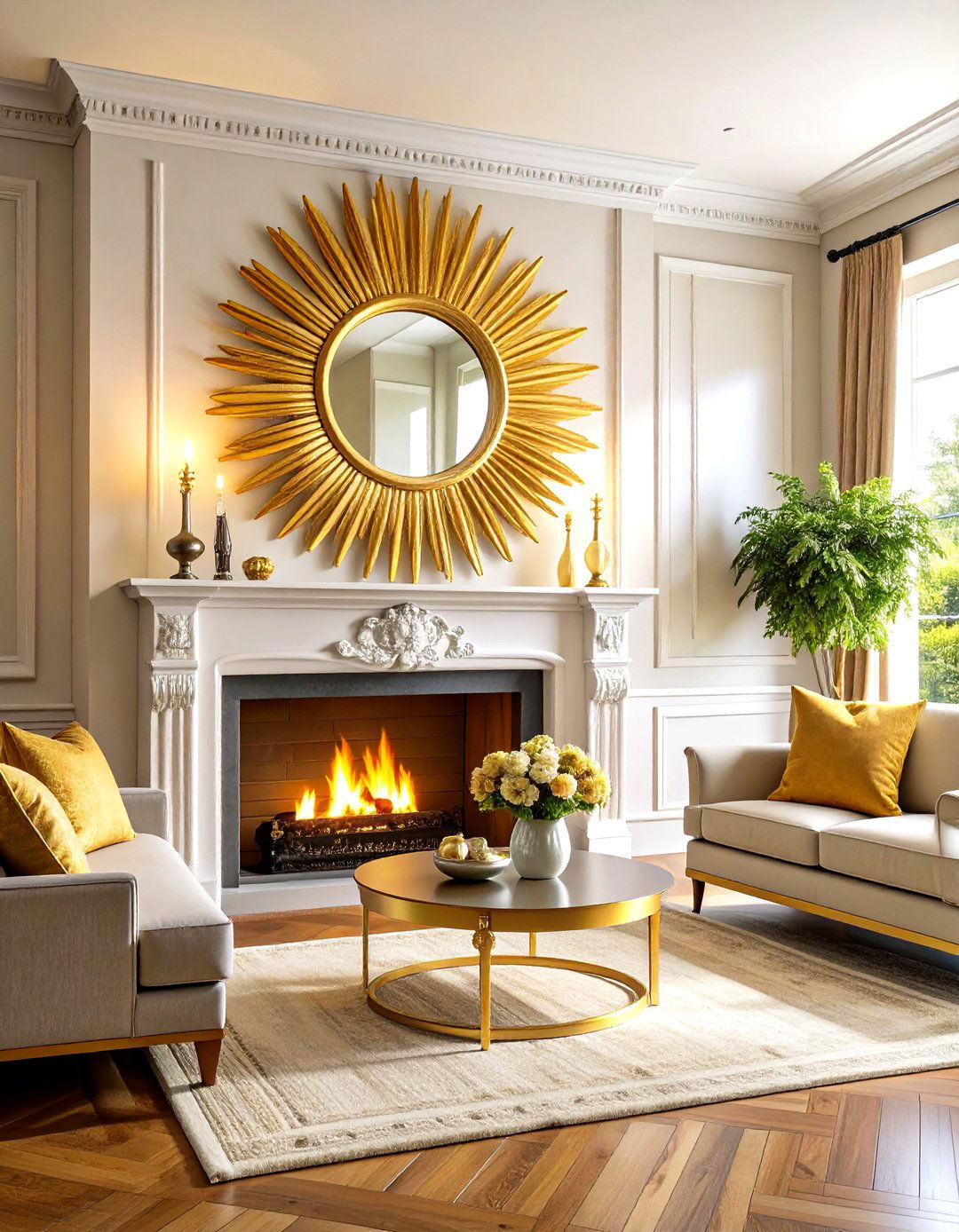

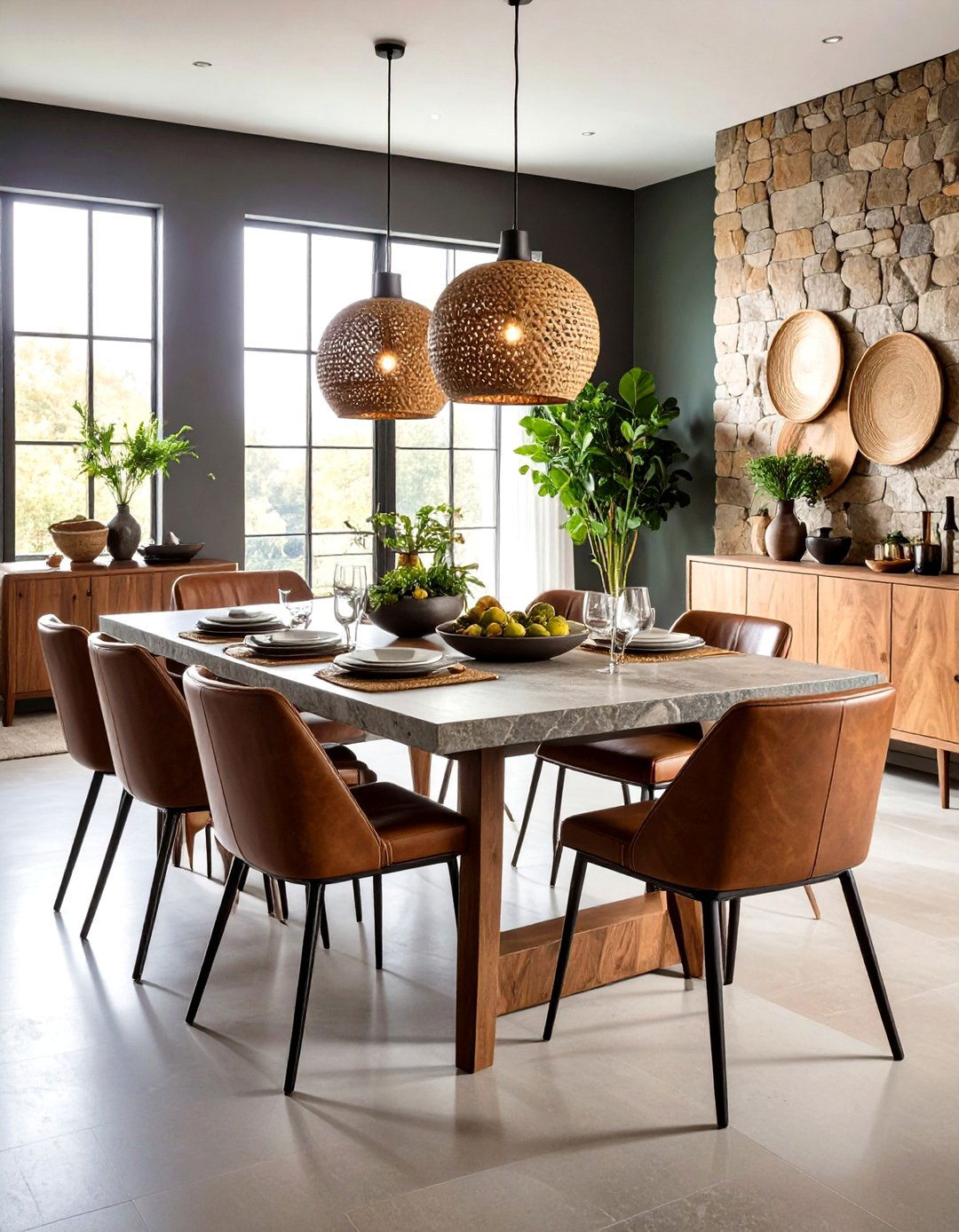
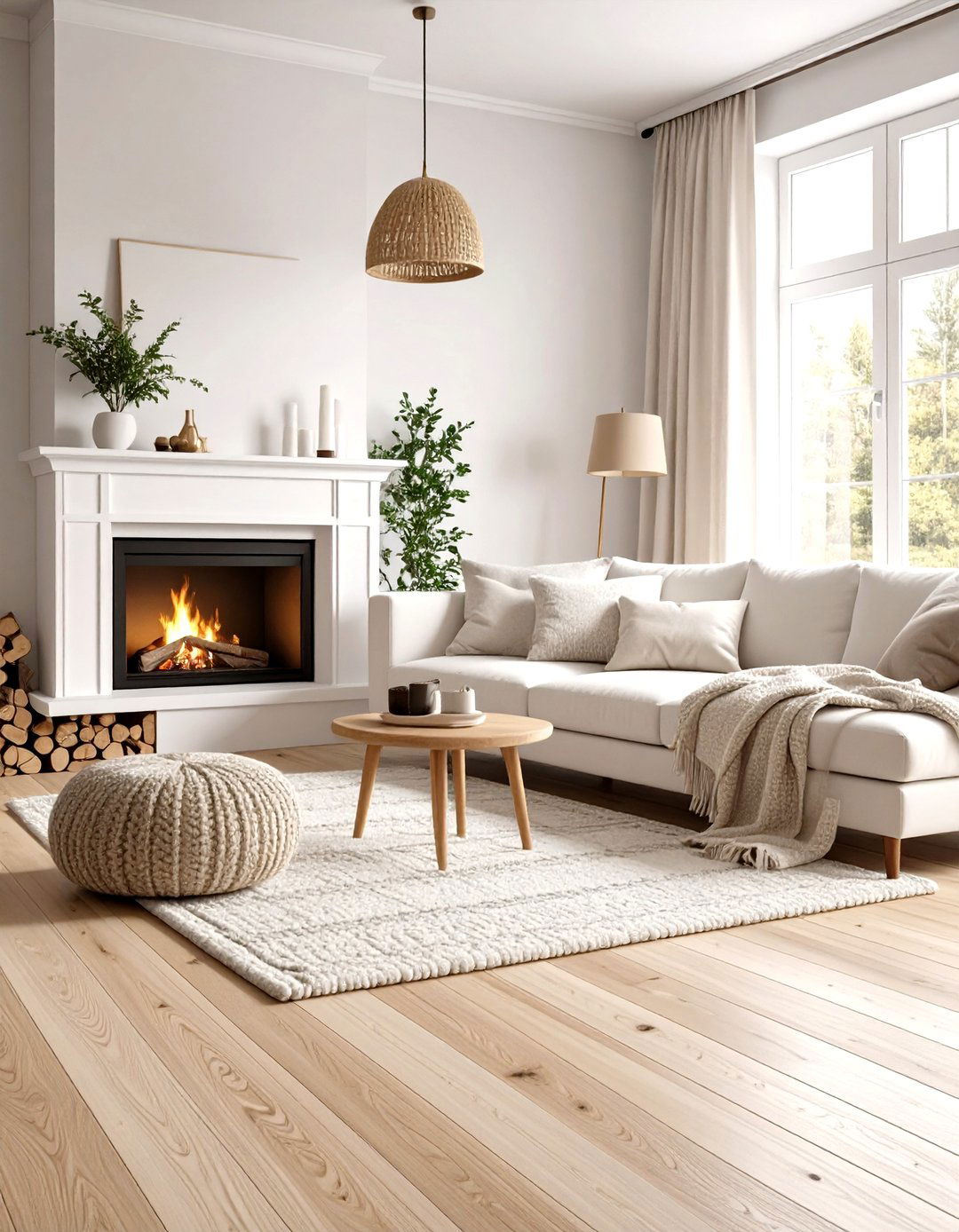
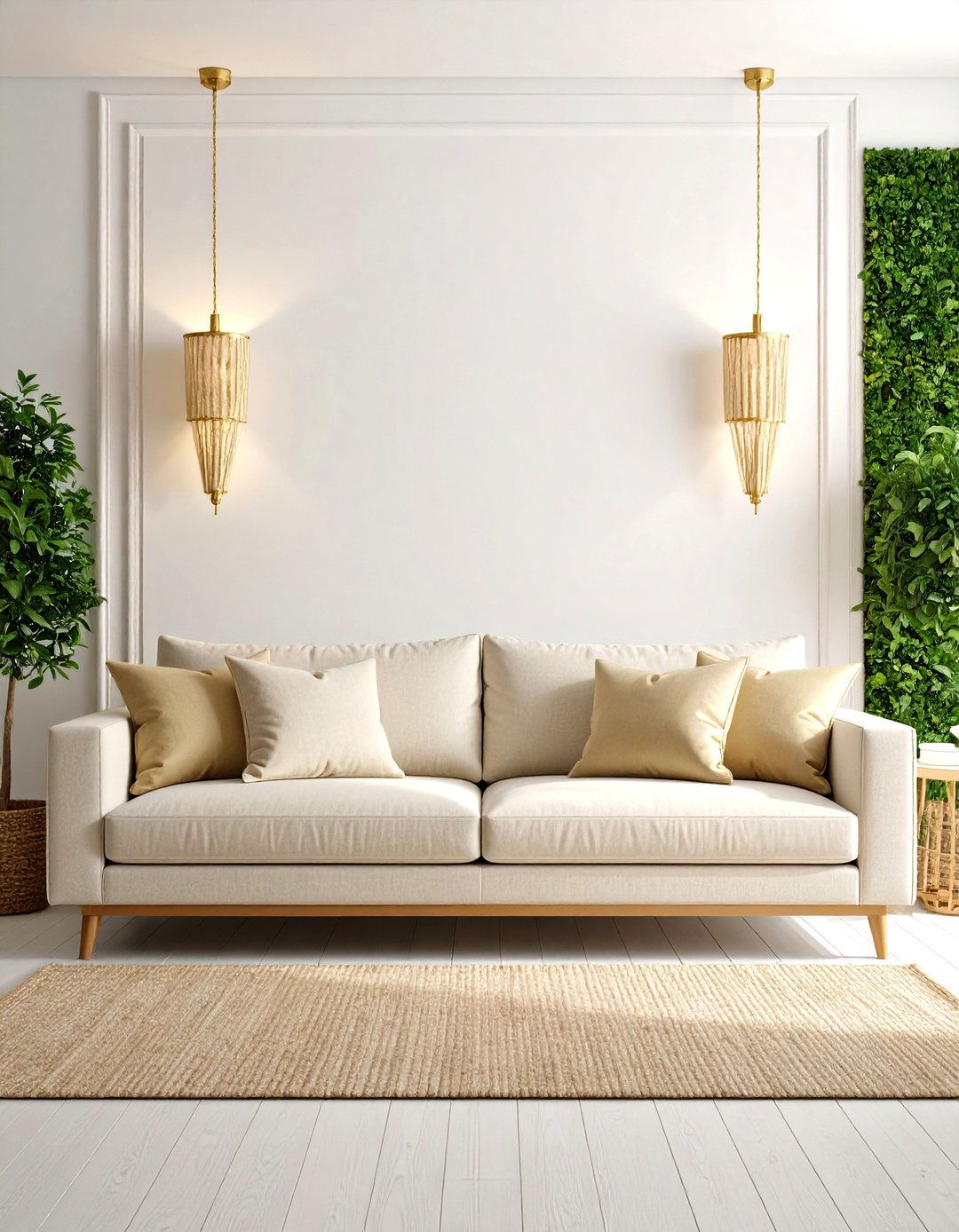
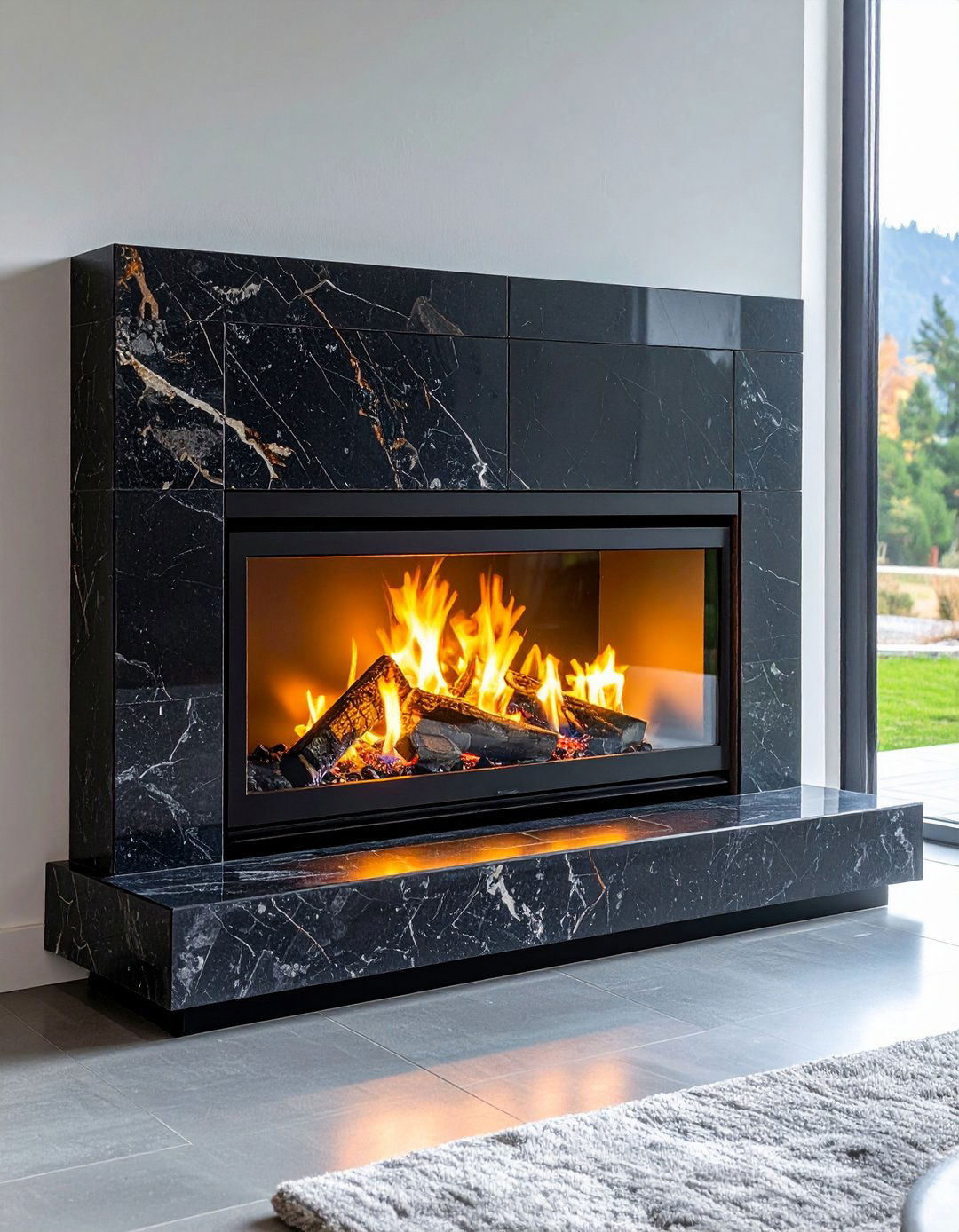

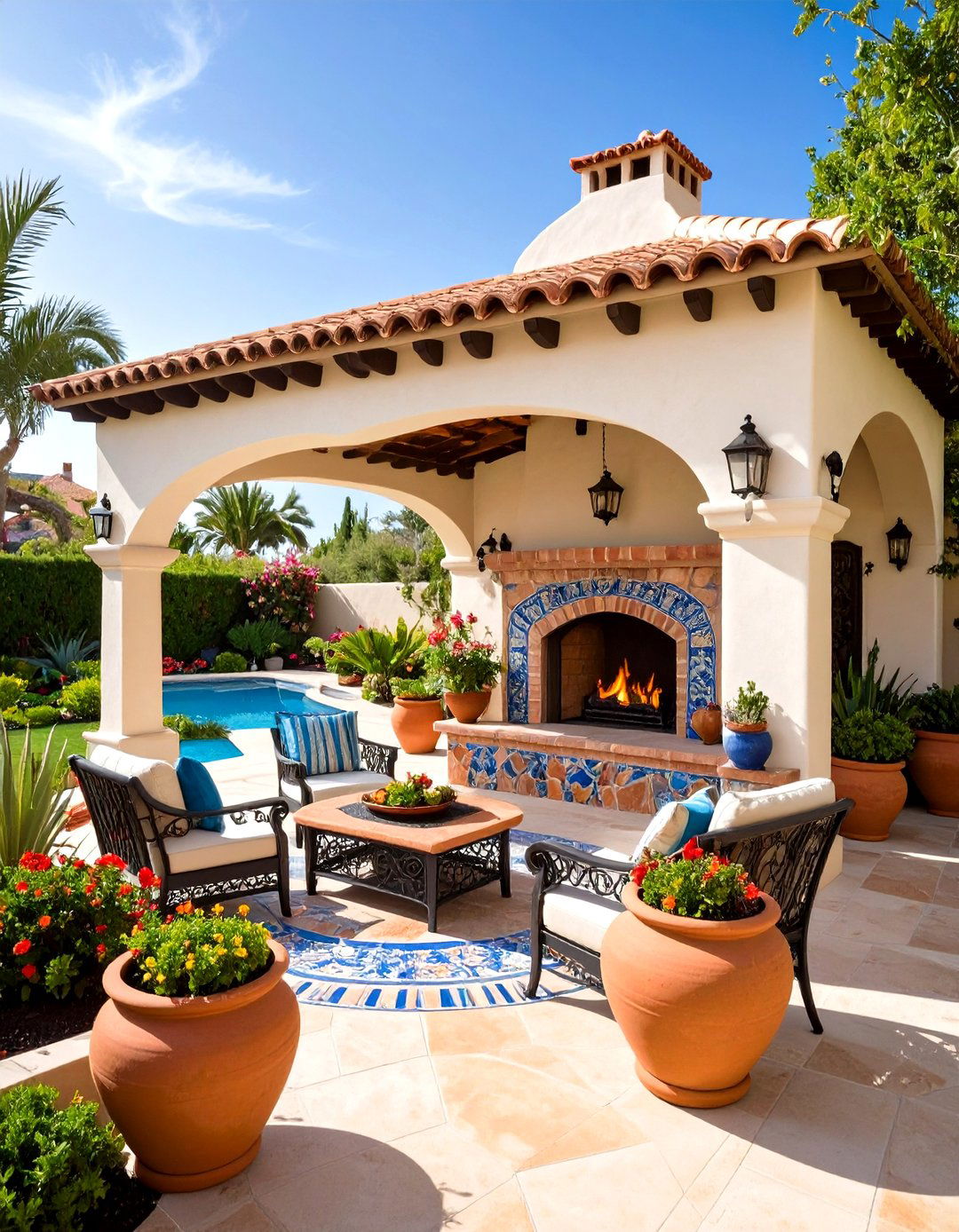
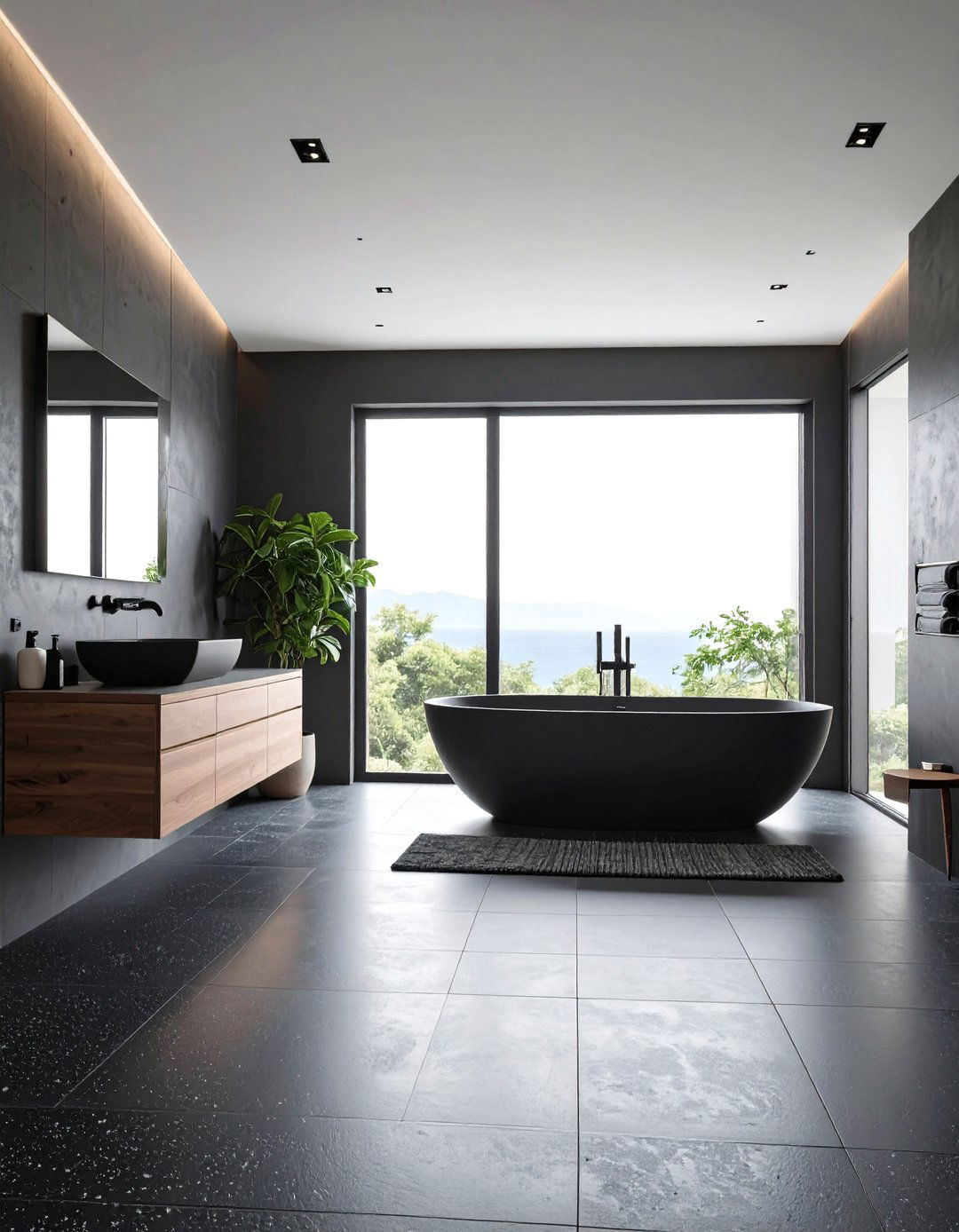
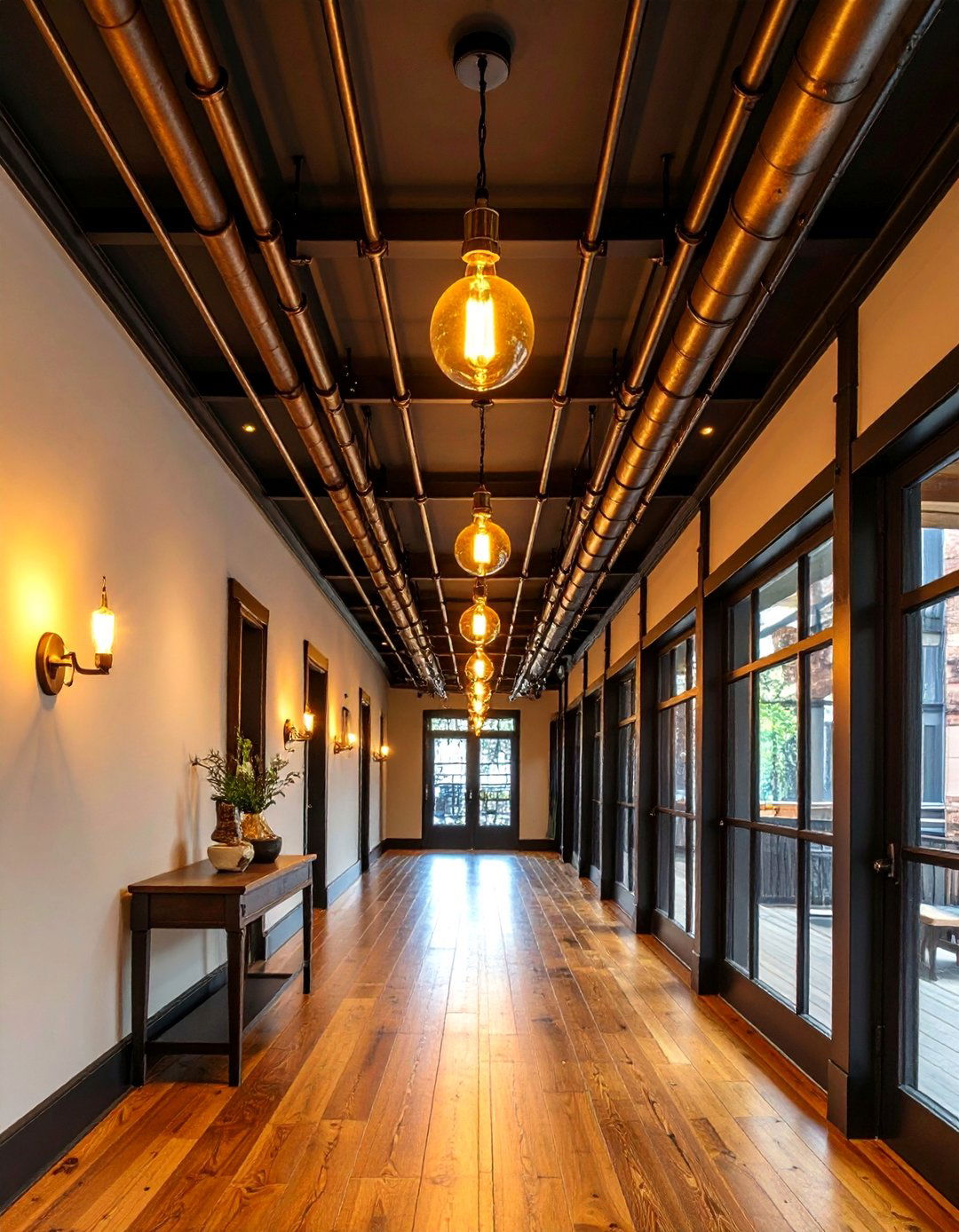
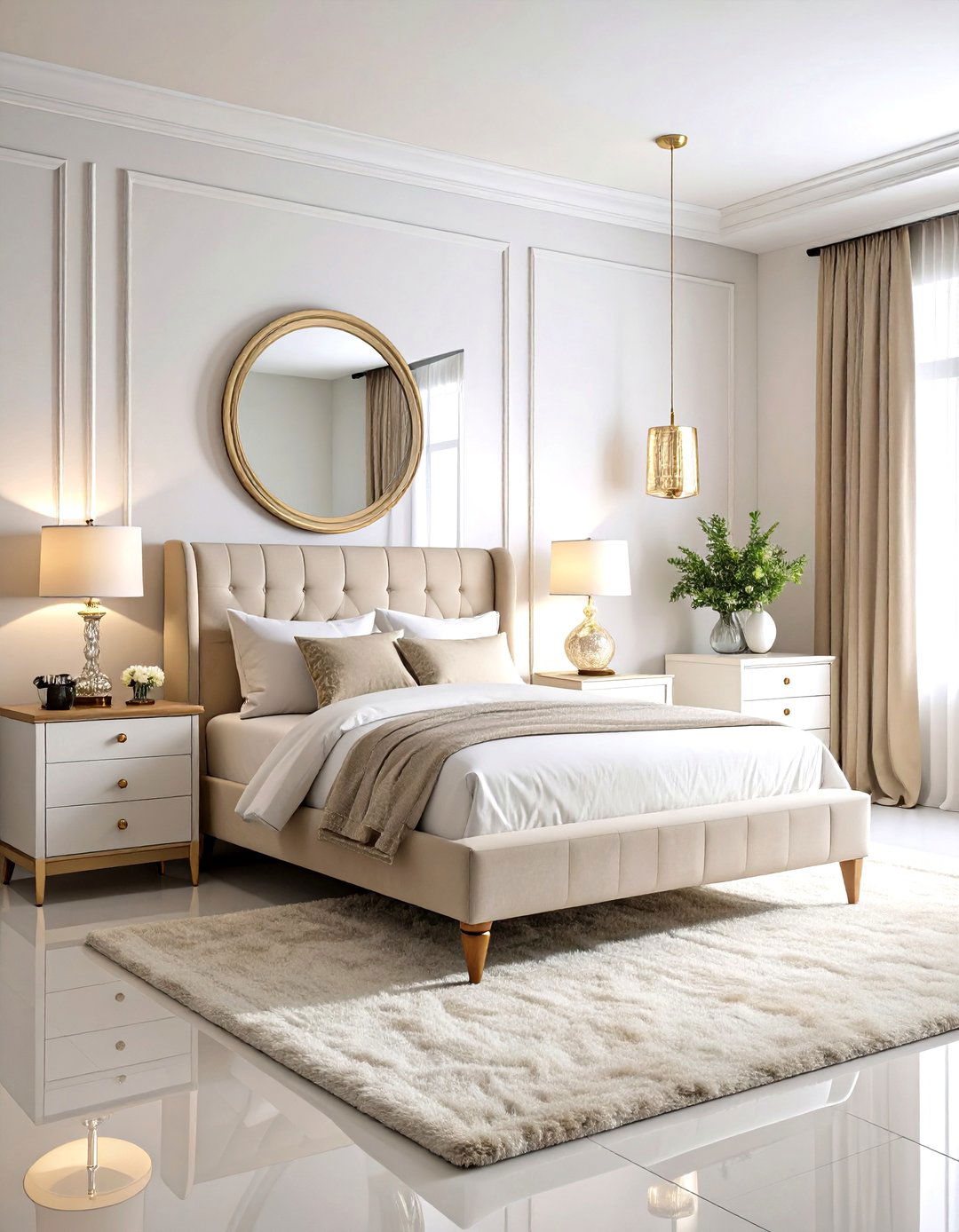
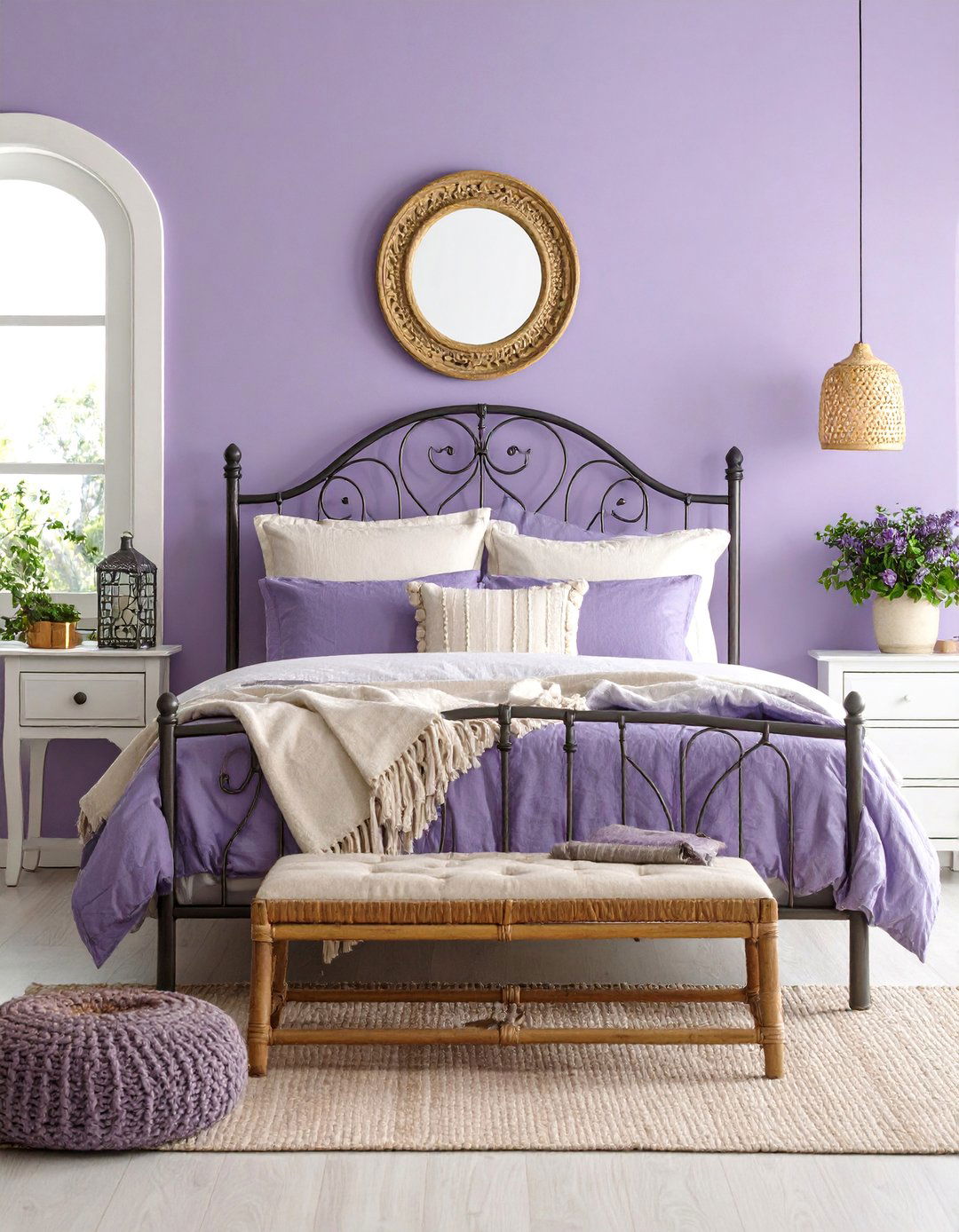
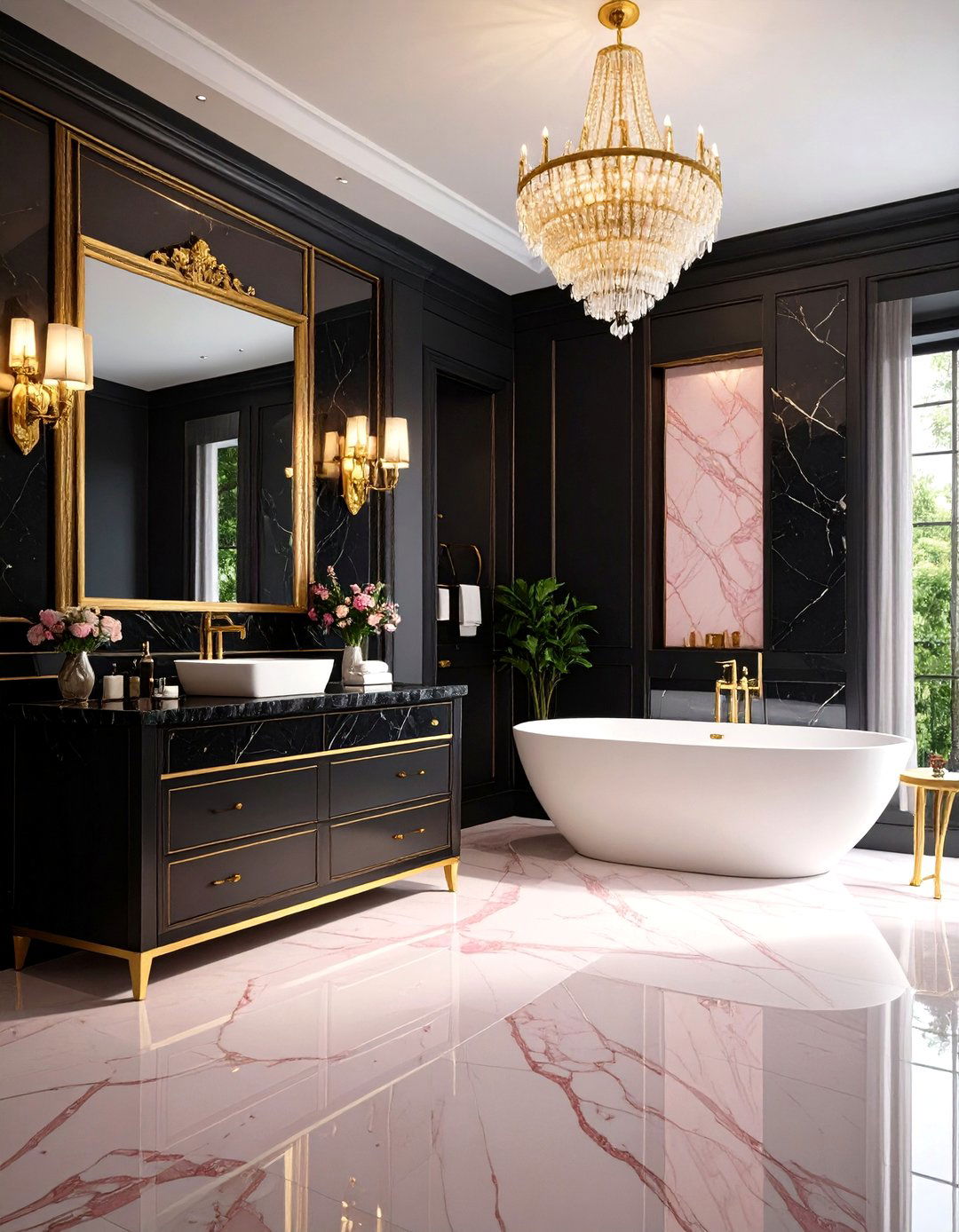

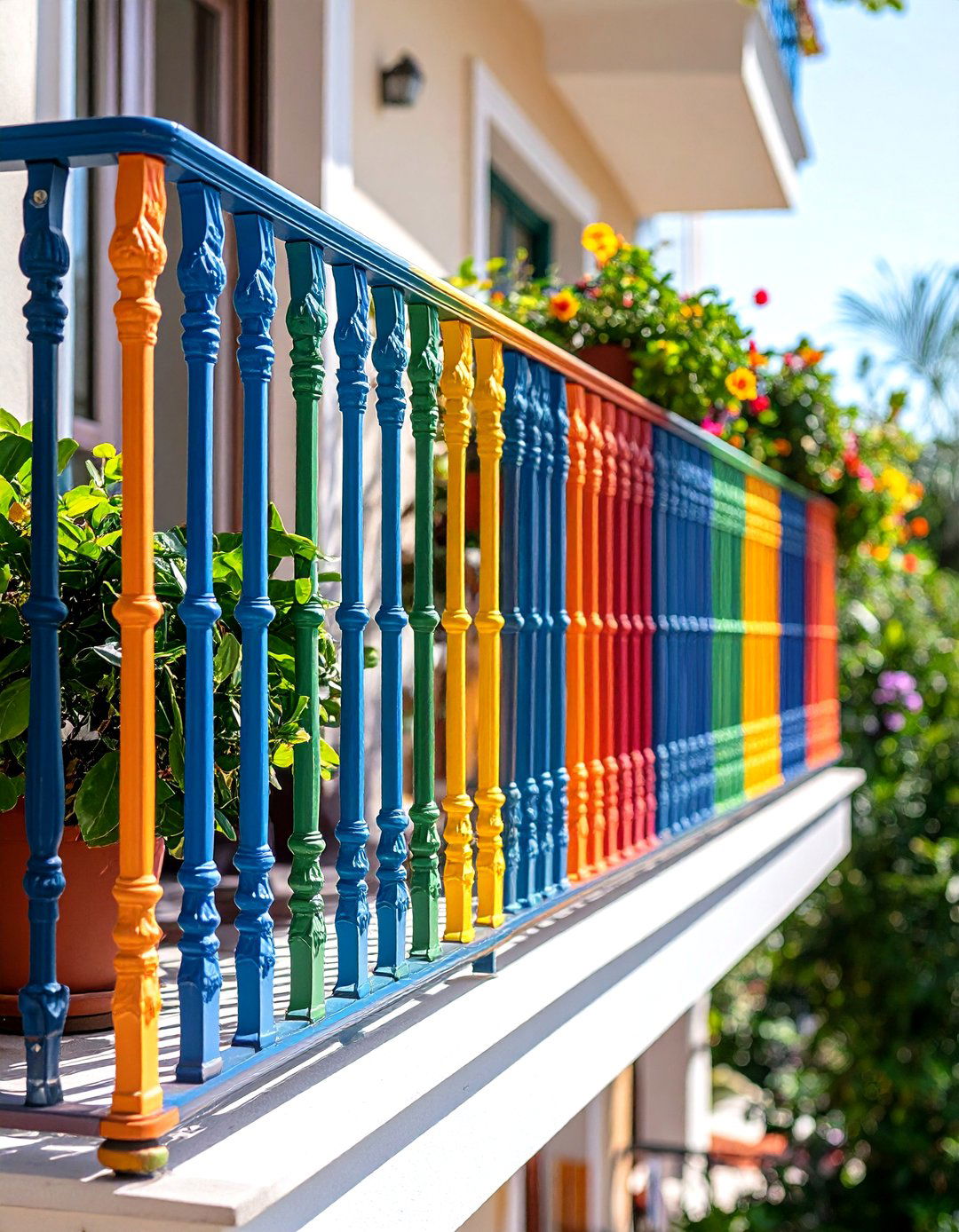
Leave a Reply